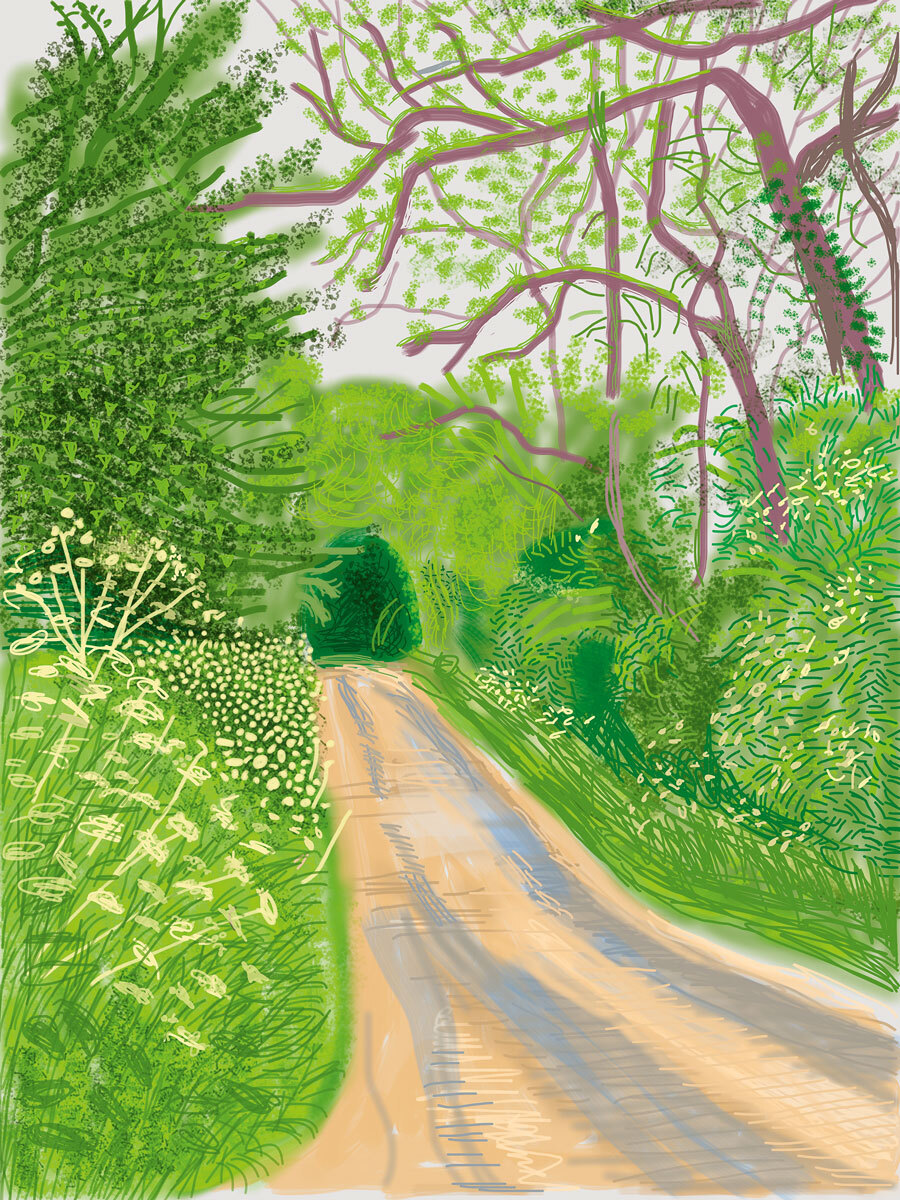David Hockney: to Normandy via Yorkshire
David Hockney: to Normandy via Yorkshire
By Edith Devaney
Published 22 March 2021
Edith Devaney, curator of our upcoming David Hockney exhibition, explores how the artist harnessed springtime to explore the drama of nature, the process of grief – and the power of hope.
-
Edith Devaney is the curator of David Hockney: The Arrival of Spring, Normandy, 2020.
David Hockney’s depictions of the natural world can be traced from his earliest paintings as a student at Bradford School of Art up to the present day. From paintings of imagined landscapes dating from the 1960s to the vast canvas Mulholland Drive: The Road to the Studio, from 1980, and his Grand Canyon works – both the photocollages from the early 1980s and the monumental paintings from the late 1990s – his works of the natural world primarily explored our perception of space.
Perhaps it is unsurprising, given the subtropical climate in California where Hockney was living from the 1980s, that the seasons were not examined, as they do not differ dramatically from each other, merely shifting from hot and dry to mild and wet.
When staying in London in 2002, Hockney experienced an English spring once again for the first time in 20 years and was reminded of the fast-moving drama that it brings. The artist relocated to Bridlington, Yorkshire, a few years later to prepare work for the Royal Academy’s 2012 A Bigger Picture exhibition.
Capturing the seasons would be key to this ambitious project and Hockney planned to witness five consecutive springs in order to produce the requisite body of work. A year out from the exhibition, the last space to be ‘filled’ was Gallery III, the largest and most prominent of the Academy’s Main Galleries.
-

David Hockney, The Arrival of Spring in Woldgate, East Yorkshire in 2011 (twenty eleven) — 16 May, 2011.
iPad painting. © David Hockney.
-
In addition to witnessing four springs, by that stage Hockney had moved from drawing on the iPhone to using the Brushes app on the newly launched iPad, spending many hours each day practising and perfecting his technique. Viewing this technology as a new medium, he experimented with printing the images directly from the iPad, determining the scale in advance, which would then inform the exact mark-making on the screen.
The iPad enabled him to capture swiftly fleeting light effects and rapid changes of the richness of spring, without having to set up painting equipment. The resulting iPad drawings, all 51 of them executed between early January and early June 2011, were printed on paper, and along with a final large-scale oil painting, constituted one work: The Arrival of Spring in Woldgate, East Yorkshire in 2011 (twenty eleven) – 16 May.
Hockney noted that it was a very classical subject, and he placed the work’s title above the painting in Romanesque lettering to emphasise this further. Hockney tackled the same subject again in 2013 following the death of his 23-year-old studio assistant Dominic Elliott, looking to the hope so present in spring to alleviate the grief of the loss of such a young life.
This cathartic undertaking – a series in charcoal on paper – has a sombre tenor, but the persistent presence of light among the shadows across all 25 works brings its own restrained element of joy. Hockney arrived in Normandy in late 2019 and decided to chart the spring there, so different from that of Yorkshire, before knowing the medium he would use.
-

David Hockney, 'Woldgate, 16 May', from The Arrival of Spring in 2013 (twenty thirteen), one of a 25-part work, 2013.
Charcoal on paper. © David Hockney.
-
He had been working with a newly developed iPad application, tailormade to his specifications: it provided him with an array of brush styles and a huge sample of colours to add to his electronic palette, and it also allowed him to work in layers.
Soon his painter’s sensibility became wholly absorbed in the possibilities and freedoms this offered him. In the short time he had been in Normandy he moved from coloured ink on paper to acrylic on canvas to the iPad, and as always with the artist, the exercise of working in the previous medium added to the expertise he brought to the next, part of the ongoing and huge accumulation of his experience. How does this depiction of the arrival of spring differ from the previous iterations? The first exploration at the RA had a more restrained quality, with the images imbued with a misty atmosphere; the second, 25 charcoal drawings, is heart-stoppingly beautiful in both execution and poignancy.
The Arrival of Spring, Normandy, 2020 is more confident and exuberant, and also are narrative in form, following in close detail the unfolding of spring as it happened – moving from plant to plant, scene to scene, in order to chart the season’s progress, so that no chapter of the drama is missed.
These iPad paintings printed on paper revel in the colour and light of his corner of Normandy, which, like Monet’s Giverny, provides him with all he needs to celebrate this most glorious of seasons.
From the Spring 2021 issue of RA Magazine, issued quarterly to Friends of the RA. David Hockney: The Arrival of Spring, Normandy, 2020 will be on show at the RA 23 May — 26 September 2021.
-

David Hockney, No. 149, 31st March 2020.
iPad painting. © David Hockney.
-
-

Enjoyed this article?
Become a Friend to receive RA Magazine
As well as free entry to all of our exhibitions, Friends of the RA enjoy one of Britain’s most respected art magazines, delivered directly to your door. Why not join the club?
-







